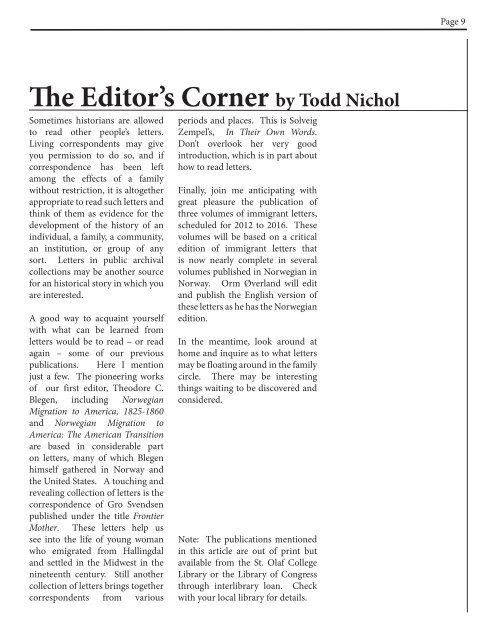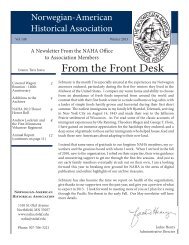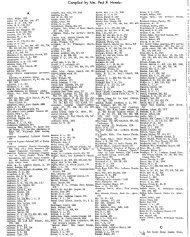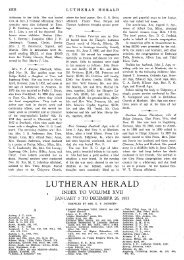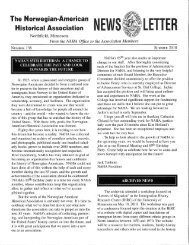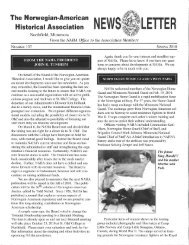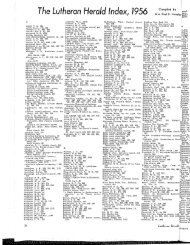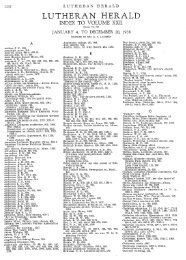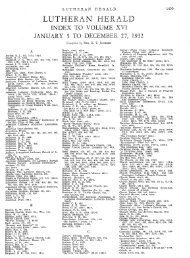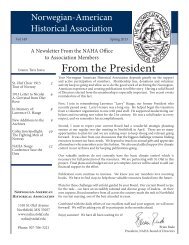Fall 2011 - Norwegian-American Historical Association - St. Olaf ...
Fall 2011 - Norwegian-American Historical Association - St. Olaf ...
Fall 2011 - Norwegian-American Historical Association - St. Olaf ...
You also want an ePaper? Increase the reach of your titles
YUMPU automatically turns print PDFs into web optimized ePapers that Google loves.
Page 9<br />
The Editor’s Corner by Todd Nichol<br />
Sometimes historians are allowed<br />
to read other people’s letters.<br />
Living correspondents may give<br />
you permission to do so, and if<br />
correspondence has been left<br />
among the effects of a family<br />
without restriction, it is altogether<br />
appropriate to read such letters and<br />
think of them as evidence for the<br />
development of the history of an<br />
individual, a family, a community,<br />
an institution, or group of any<br />
sort. Letters in public archival<br />
collections may be another source<br />
for an historical story in which you<br />
are interested.<br />
A good way to acquaint yourself<br />
with what can be learned from<br />
letters would be to read – or read<br />
again – some of our previous<br />
publications. Here I mention<br />
just a few. The pioneering works<br />
of our first editor, Theodore C.<br />
Blegen, including <strong>Norwegian</strong><br />
Migration to America, 1825-1860<br />
and <strong>Norwegian</strong> Migration to<br />
America: The <strong>American</strong> Transition<br />
are based in considerable part<br />
on letters, many of which Blegen<br />
himself gathered in Norway and<br />
the United <strong>St</strong>ates. A touching and<br />
revealing collection of letters is the<br />
correspondence of Gro Svendsen<br />
published under the title Frontier<br />
Mother. These letters help us<br />
see into the life of young woman<br />
who emigrated from Hallingdal<br />
and settled in the Midwest in the<br />
nineteenth century. <strong>St</strong>ill another<br />
collection of letters brings together<br />
correspondents from various<br />
periods and places. This is Solveig<br />
Zempel’s, In Their Own Words.<br />
Don’t overlook her very good<br />
introduction, which is in part about<br />
how to read letters.<br />
Finally, join me anticipating with<br />
great pleasure the publication of<br />
three volumes of immigrant letters,<br />
scheduled for 2012 to 2016. These<br />
volumes will be based on a critical<br />
edition of immigrant letters that<br />
is now nearly complete in several<br />
volumes published in <strong>Norwegian</strong> in<br />
Norway. Orm Øverland will edit<br />
and publish the English version of<br />
these letters as he has the <strong>Norwegian</strong><br />
edition.<br />
In the meantime, look around at<br />
home and inquire as to what letters<br />
may be floating around in the family<br />
circle. There may be interesting<br />
things waiting to be discovered and<br />
considered.<br />
Note: The publications mentioned<br />
in this article are out of print but<br />
available from the <strong>St</strong>. <strong>Olaf</strong> College<br />
Library or the Library of Congress<br />
through interlibrary loan. Check<br />
with your local library for details.


